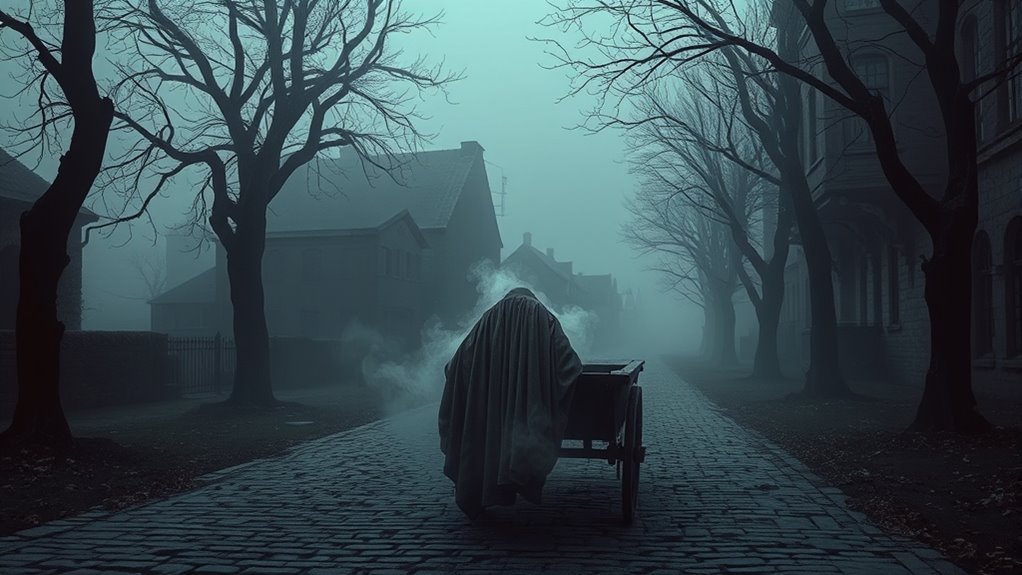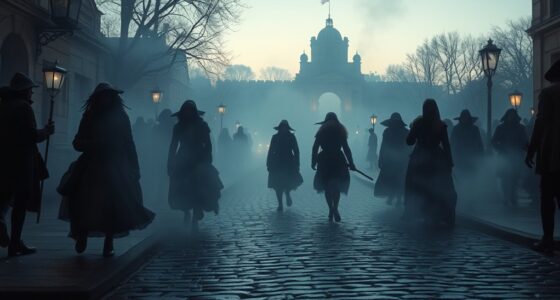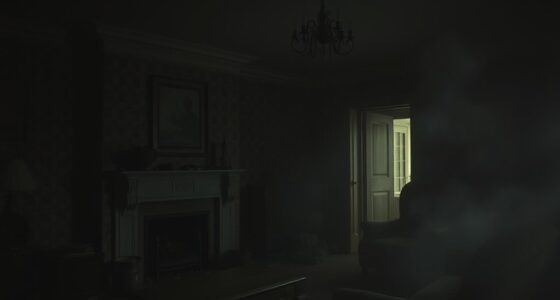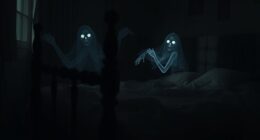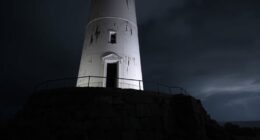The Black Plague deeply influenced how people perceived death and the supernatural. High death tolls led to ghostly sightings and beliefs about restless souls seeking resolution. Many viewed these apparitions as messages or warnings, triggering community rituals for appeasement. Folklore emerged, painting witches and curses as scapegoats for the plague. Amidst this turmoil, religion struggled to provide solace, igniting fears and accusations. This cultural upheaval left a lasting mark on modern paranormal narratives that you might find intriguing.
Key Takeaways
- The Black Death led to increased reports of ghostly apparitions, often linked to improper burials and societal grief.
- Communities engaged in rituals to appease restless souls, integrating supernatural beliefs into daily practices.
- Folklore emerged around curses attributed to witches and vengeful spirits, fueling societal scapegoating and unrest.
- The perception of the plague as divine punishment intensified religious fervor and accusations of witchcraft, impacting community dynamics.
- The Black Death inspired modern ghost stories and paranormal tourism at sites associated with the plague’s tragic history.
The Cultural Impact of Grief and Loss
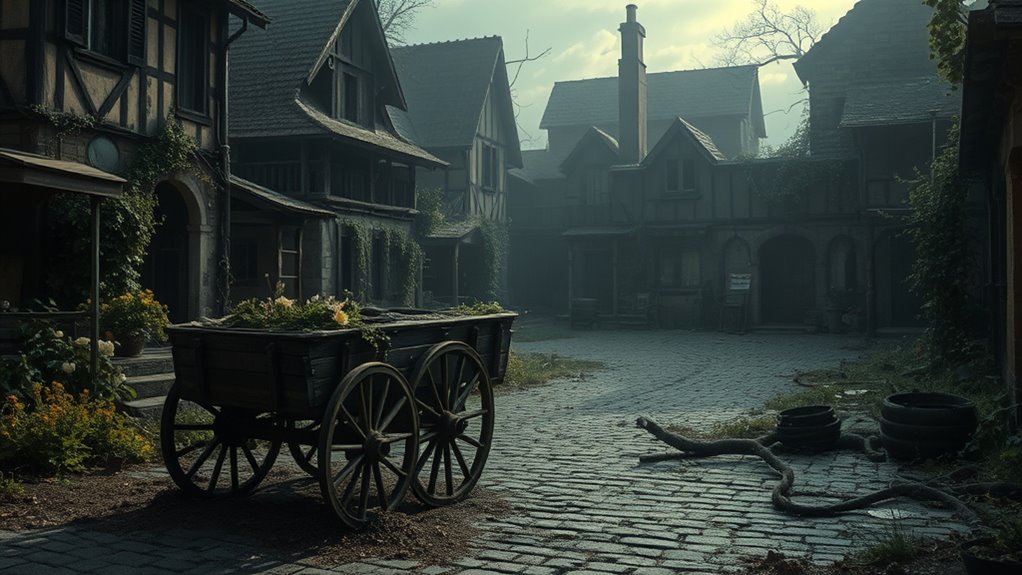
As the Black Death swept through Europe, it didn’t just claim lives; it profoundly altered the cultural landscape. The overwhelming mortality and collective loss led to a significant cultural shift, evident in art and literature that embraced themes of despair and the fleeting nature of life.
You might notice works like Giovanni Boccaccio’s “The Decameron” reflecting these sentiments. This grief fostered a fascination with death, as seen in the “Danse Macabre” motif, which illustrated that death unites all, regardless of status.
Survivors turned to religion for solace, igniting movements like the Flagellants seeking atonement. Communities erected memorials, showcasing their need to remember.
In their grief, survivors sought solace in faith, giving rise to movements like the Flagellants and the creation of memorials to honor the departed.
Ultimately, these experiences shaped worldviews and laid the groundwork for Renaissance humanism and individualism.
Ghostly Apparitions and Restless Souls

The aftermath of the Black Death ignited a wave of ghostly apparitions and restless souls, enchanting the imaginations of those left behind.
With a staggering high mortality rate, many regions reported encounters with the dead walking among the living, often attributed to souls denied proper burials. Families, reeling from the sudden loss of loved ones, became fixated on these sightings, believing they were omens or warnings.
Communities performed rituals to appease these restless souls, hoping to find solace amidst the chaos. Tales of spectral figures haunting places marked by mass graves spread rapidly, reflecting society’s trauma.
This heightened sensitivity to death influenced art, literature, and religious practices, intertwining the supernatural with daily life in profound ways.
Folklore and Tales of Curses
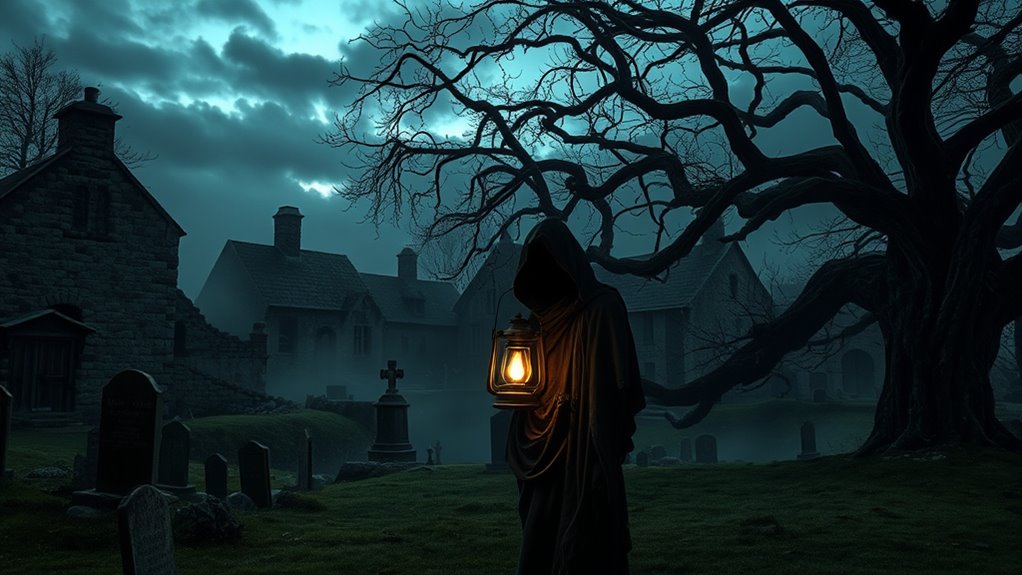
While many sought answers to the devastation wrought by the Black Death, folklore surrounding curses emerged as a powerful narrative.
Communities turned to tales of supernatural forces, believing the plague was a manifestation of witches’ curses or the wrath of vengeful spirits. Marginalized groups, especially women and children, became scapegoats, accused of invoking divine retribution through curses.
The fear of the unknown fueled apocalyptic stories, linking the disease to biblical prophecies and moral decay. This atmosphere of fear and suspicion escalated violence against the accused, leading to tragic massacres.
As people grappled with their suffering, these curses and supernatural beliefs deepened the social unrest, shaping a haunting legacy of the plague that lingered long after the bodies were buried.
The Role of Religion in the Supernatural Beliefs
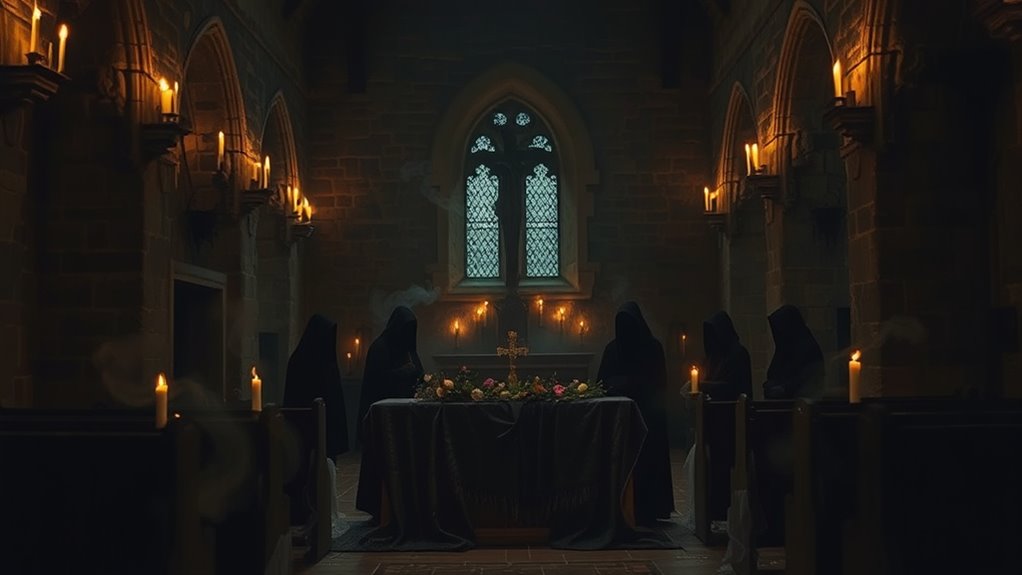
You’ll notice that during the Black Plague, many believed the disease was God’s punishment for humanity’s sins, leading to intense religious fervor.
This surge in fanaticism often resulted in witch hunts and the scapegoating of marginalized groups, particularly Jews, as communities searched for someone to blame.
As fear spread, so did the idea that divine retribution was at play, shaping a dark chapter in religious history.
Divine Punishment Beliefs
Amid the chaos of the Black Death, many people viewed the plague as divine punishment for humanity’s sins, fostering a climate of fear and despair.
An extraordinary number of lives were claimed, leading to a heightened sense of impending doom. Religious leaders struggled to provide comfort, often appearing inadequate in the face of such widespread suffering.
In their desperation, communities turned to extreme penance and self-mortification, hoping to appease an angry God. This belief in divine punishment fueled a surge of religious fervor, as people engaged in fervent prayers and public displays of devotion, seeking divine intervention.
However, the Church’s inability to offer answers contributed to a significant decline in its authority, leaving many questioning established doctrines.
Witch Hunts and Scapegoating
As fear spread through Europe during the Black Death, communities sought to blame someone for the devastation, leading to a surge in witch hunts and scapegoating. Many targeted Jewish communities, falsely accusing them of poisoning wells, resulting in violent massacres.
That’s one of the darkest chapters of this era. Religious fervor intensified, with people viewing the plague as divine punishment for sin, which fueled accusations of witchcraft.
The societal chaos created fertile ground for superstition, particularly against vulnerable groups like women, who were often seen as sources of evil.
I’m sure you can see how this blend of fear and desperation tore at social cohesion, as communities looked for scapegoats in their quest to rationalize the unimaginable mortality rates.
Scapegoating and the Fear of the Unknown
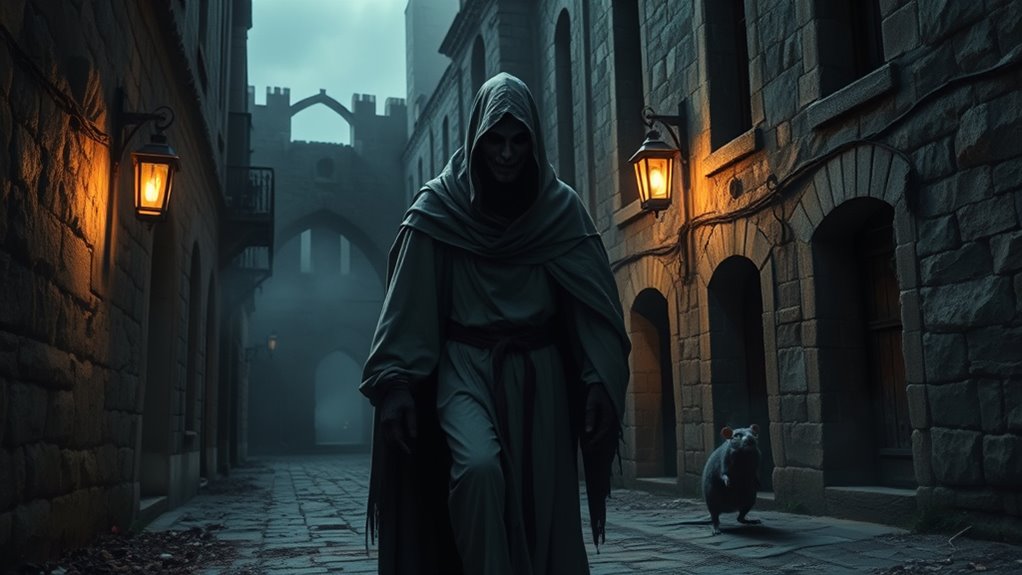
While fear of the unknown gripped society during the Black Plague, scapegoating became a tragic response to the chaos. In this turbulent time, people sought to blame others for their suffering, leading to devastating consequences.
Key aspects of this phenomenon included:
- Jewish communities were falsely accused of poisoning wells, resulting in massacres.
- Conspiracy theories emerged, claiming specific groups were responsible for the plague.
- Many turned to superstition, believing divine punishment or witchcraft caused the disease.
- Families abandoned infected members, sparking societal breakdown and mass hysteria.
These reactions not only intensified social tensions but also highlighted humanity’s tendency to seek explanations for unimaginable crises, even if those explanations led to violence and despair.
The Lasting Influence on Modern Paranormal Narratives
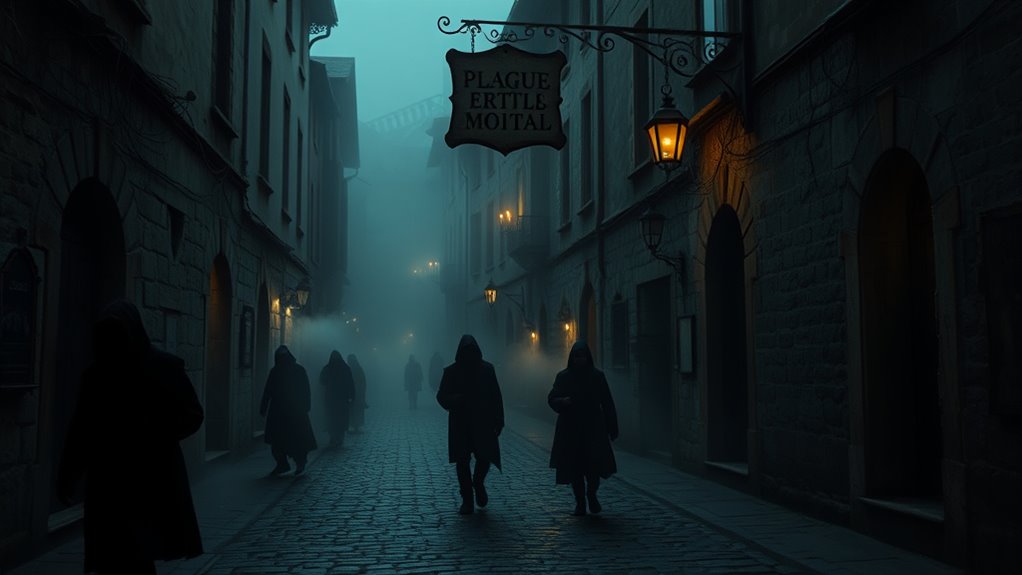
The Black Death not only reshaped society in its time but also left an indelible mark on modern paranormal narratives. Its staggering death toll fueled superstitions about divine punishment and witchcraft, themes that still echo in today’s storytelling.
The plague’s rapid spread and the fear it instilled inspired ghost stories and tales of the undead, influencing writers like Edgar Allan Poe. The fascination with death birthed ghost hunting and spiritualism in the 19th century.
Folklore about cursed places and haunted sites emerged from the desolation left behind, giving rise to chilling narratives. Today, the macabre allure of the plague continues to draw paranormal tourists, with locations tied to the Black Death marketed as hotspots for those seeking supernatural encounters. This enduring fascination highlights the paranormal narratives that have evolved as a result of historical tragedies.
Frequently Asked Questions
What Were the Aftereffects of the Black Plague?
After the Black Plague, you’d notice a profound shift in society. The massive death toll created labor shortages, empowering the working class and weakening feudalism.
Fear and superstition took hold, leading to scapegoating, particularly against Jews, resulting in violence and expulsions.
Culturally, you’d see a fascination with death reflected in art and literature.
Additionally, advancements in public health emerged, as communities recognized the importance of sanitation and quarantine to prevent future pandemics.
What Are the Six Effects of the Black Death?
The Black Death had several considerable effects.
You’d notice a drastic population decline, leading to labor shortages and increased wages for workers.
Social upheaval would emerge, causing tensions and scapegoating of marginalized groups.
You’d see families abandoning loved ones, fostering despair.
The clergy would dwindle in numbers, resulting in a decline in religious guidance.
Finally, laywomen would start taking on more roles in church services, altering religious practices considerably.
What Were Two Major Results of the Black Plague?
“Where there’s a will, there’s a way.”
The Black Plague drastically changed society in two major ways.
First, it caused a significant labor shortage, leading to higher wages for workers who survived, shifting the balance of power.
Second, the decline in the clergy resulted in a shortage of trained leaders, allowing laypeople, especially women, to take more active roles in religious practices.
These shifts laid the groundwork for future social transformations.
What Did the Black Plague Do to Your Body?
The Black Plague wreaks havoc on your body. You experience high fevers, severe headaches, and nausea, while swollen lymph nodes, or bubos, cause intense pain.
If the infection worsens, black spots appear on your skin, signaling critical internal damage. The rapid onset of these symptoms means you could face a grim prognosis, with untreated cases leading to an alarming mortality rate.
In just days, your health deteriorates dramatically, leaving little chance for survival.
Conclusion
In the wake of the Black Plague, the intertwining of grief and the supernatural shaped an entire cultural landscape. Ghostly apparitions and tales of curses reflected society’s struggle with loss and fear. Religion played a pivotal role in guiding beliefs about the afterlife and restless souls. As you explore modern paranormal narratives, you might wonder: how much of our fascination with the supernatural stems from humanity’s ancient attempts to make sense of tragedy? The echoes of that past still resonate today.
